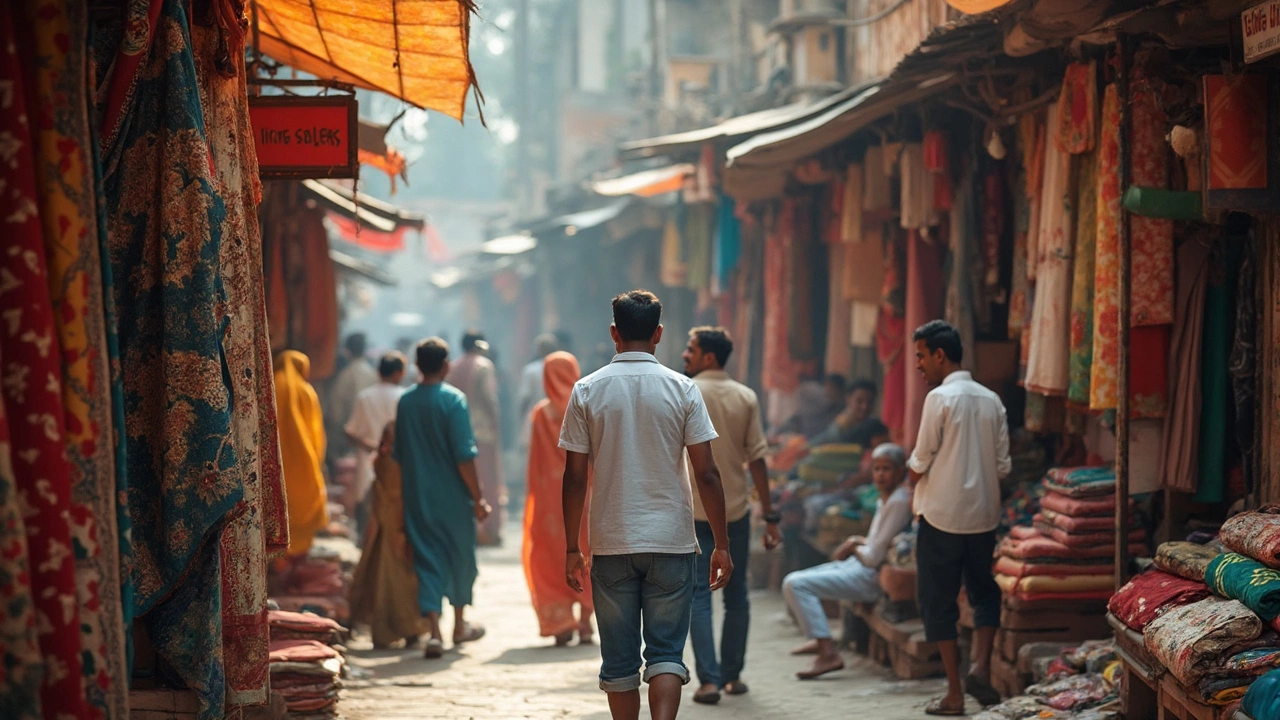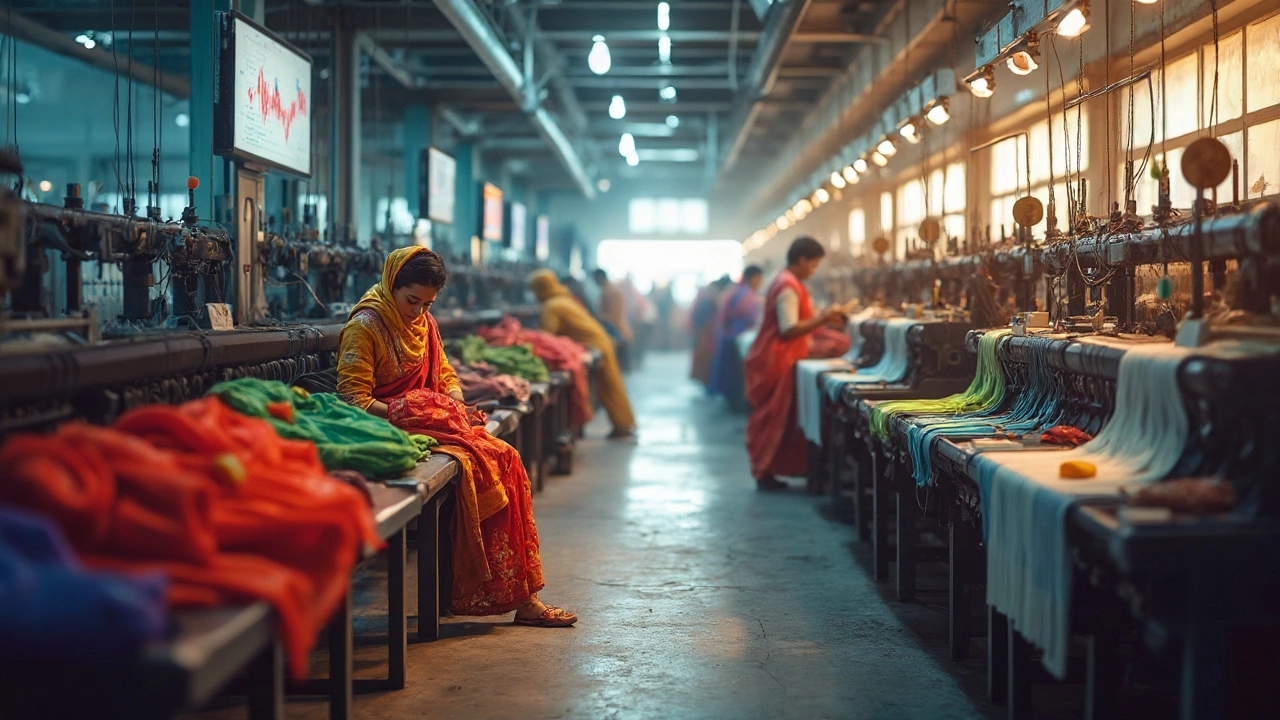Think all textile businesses make the same kind of money? Not even close. Some sectors are cash cows, while others are just scraping by. In India, where textiles power more than 4.5 crore jobs, picking the right niche can be the difference between big profits and just getting by.
Ask any seasoned textile manufacturer in Tiruppur or Surat, and they’ll tell you: margins can swing wildly. Making basic cotton shirts? You’re in a market that’s always crowded, so margins stay thin—often 5-7%. Now compare that to technical textiles—stuff used in healthcare, automotive, or sports. These sectors have margins going beyond 15%, and sometimes north of 20% for niche products. The booming demand makes it a seller’s market if you play your cards right.
Don’t think you need a massive investment to make it work. Sometimes, it’s about picking the right product or focusing on export markets, where buyers pay a premium for quality and innovation. The rise of sustainability and digital printing is shaking up the game. Even traditional sectors like silk and handloom can give great returns—if you snag the right buyers.
- Profit Margins Across Textile Segments
- Hot Sectors: Cotton vs. Technical Textiles
- What Sets Successful Textile Businesses Apart
- Current Market Trends Shaping Profits
- Smart Moves for Higher Profits
Profit Margins Across Textile Segments
Not all textile businesses in India bring in the same profits. Your bottom line depends a lot on what you choose to make and who your buyers are. Here’s a breakdown of how different sectors are doing in terms of margins right now.
| Textile Segment | Average Profit Margin (%) | Key Factors |
|---|---|---|
| Cotton Garments | 5-8 | High competition, stable demand |
| Readymade Apparel (Export) | 8-12 | Quality, export incentives |
| Technical Textiles | 12-22 | Low competition, innovation, rising demand |
| Home Textiles (Bed, Bath, Furnishings) | 10-14 | Branding, export focus |
| Handloom & Silk | 8-18 | Niche buyers, value addition |
The textile business India landscape is shaped by demand, input costs, and how crowded each market is. Cotton spinning units, for example, usually see the thinnest profits due to tough competition and regular price swings in raw cotton. As per 2024 data, profit margins for cotton textiles are mostly in single digits, making it tough for newcomers without strong supply chains.
If you look at technical textiles—like those used for making medical fabrics, geotextiles for roads, or materials for sports gear—you’ll notice the numbers jump. These sectors aren’t just profitable because they’re new; they’re also not flooded with small players, so prices stay healthy.
Home textile exporters are on an upswing, too, thanks to strong demand from the US and Europe. If you have good designs, high quality, and a reliable delivery system, you can hit double-digit margins here. On the flip side, basic readymade garments that aren’t branded struggle to rise above 8-10%, especially if you sell only in price-sensitive domestic markets.
For those thinking small scale, traditional silk and handloom products can look attractive. The trick is finding buyers willing to pay a premium for craftsmanship. B2B platforms and e-commerce have made it easier for smaller players to reach international customers in the last two years. More than a third of handloom exporters today use online platforms—and their profit margins have grown by around 30% in just the past year.
Bottom line? Focus on sectors with less competition, rising demand, or chances to offer something unique. That’s where you’ll find steady profits, rather than razor-thin margins and price wars.
Hot Sectors: Cotton vs. Technical Textiles
If you're just stepping into the Indian textile business India scene, it’s tempting to think anything with "cotton" in it is the way to go. After all, India is the world’s largest cotton producer. But here’s the kicker: while cotton is everywhere and still pulls in big export numbers, its profit margins don’t always stack up against the rising stars—technical textiles.
Cotton textiles are your everyday stuff: t-shirts, bedsheets, denim, and towels. Easy to sell, easy to find buyers, but you fight for every rupee because of heavy competition. Average net margins? Usually just 5-7%. You’ll need huge volume to make serious money, and sudden swings in raw cotton prices can mess with your costs.
Now, look at technical textiles. This covers everything from medical PPE kits to geotextiles used in highways, to fancy materials in sportswear and cars. It’s a massive sector that’s seen double-digit growth for the past five years. While India’s technical textile market hit about $22 billion in 2023, it’s still just catching up to China and the US, so there’s serious room to grow.
| Segment | Market Size (2023) | Profit Margin | Growth Rate (YoY) |
|---|---|---|---|
| Cotton Textiles | $18.5B | 5-7% | 3% |
| Technical Textiles | $22B | 12-20% | ~10% |
Why are technical textiles flying? For starters, government schemes like PLI (Production Linked Incentives) give cash-back incentives for technical textile units. Plus, there’s hardly any price war—customers buying filters for water plants or industrial safety gear care more about certification and performance than pinching pennies.
- Technical textiles are less affected by fashion trends—demand is driven by industries, not the latest Bollywood look.
- There’s a premium on innovation. If you bring in something unique, like anti-bacterial fabrics or fire-retardant gear, you can charge extra.
- Exports are surging: Indian PPE kit exports jumped 600% during the pandemic and haven’t really slowed down for specialty products.
If you’ve got to pick, cotton is steady but crowded. Technical textiles are less crowded, growing faster, and bringing fatter profits. Lots of successful players are shifting at least half their investments from regular cotton mills to technical textile lines because the future looks much brighter there.

What Sets Successful Textile Businesses Apart
You spot a busy textile factory churning out orders year-round, while another down the street struggles to keep the lights on. What’s the difference? It’s not luck—it’s smart decisions stacked one after another. Let’s break down what gives winners the edge.
- Specialization: Winners often focus on a specific market—say, eco-friendly fabrics or tech-infused clothing—rather than trying to please everyone. For example, Indian brands like Welspun and Garware Technical Fibres have carved global niches by sticking to what they do best.
- Modern Machinery: Outdated looms and manual setups kill margins fast. Businesses that invest in automation—like digital printing machines or high-speed weaving—see faster delivery and fewer errors. According to a 2024 survey by the Confederation of Indian Textile Industry, automated plants show up to 30% higher profit-per-employee compared to those using older setups.
- Strong Supply Chains: Consistent raw material supply means no factory downtime. Companies with good supplier agreements (either long-term or by building their own spinning units) avoid price shocks and meet deadlines more reliably.
- Exports: Factories that crack the export game earn in dollars or euros. India’s textile exports reached $44 billion in 2023, with the most successful players often landing deals with brands abroad. Export-focused plants earn higher margins—an average of 10-15% more per product than domestic-only units.
- Certifications and Compliance: Having global certifications like OEKO-TEX or GOTS is non-negotiable for premium buyers, especially in Europe and North America. These open premium markets and boost trust instantly.
Here’s a quick comparison of key factors between profitable and struggling businesses:
| Factor | Highly Profitable | Low-Profit/Risky |
|---|---|---|
| Product Focus | Specialized (e.g. technical textiles) | Generic, undifferentiated |
| Machinery | Modern, automated | Old, manual |
| Target Market | Exports/Innovative segment | Mass-market, low-price |
| Certifications | Global standards (OEKO-TEX, GOTS) | Few or none |
| Supply Chain | Integrated or long-term contracts | Ad-hoc purchasing |
If you want to get ahead in the textile business India scene, skip the shortcuts. Instead, invest in quality, build solid supplier relations, and aim for international buyers. Reliability, speed, and specialty are the secret sauce that keep profit margins healthy year after year.
Current Market Trends Shaping Profits
The textile business India scene isn’t stuck in the past—actually, things are moving pretty fast. A lot of these shifts are coming straight from what buyers want, what exports are doing, and, believe it or not, government moves.
Eco-friendly fabrics are serious business now. Indian manufacturers who use organic cotton, recycled polyester, or even banana fiber are landing big export orders. H&M and Zara are grabbing up eco-textiles from India, and the numbers prove it: according to the Indian Brand Equity Foundation, organic apparel exports grew over 19% last year alone.
Technical textiles are blowing up. Think medical PPE kits, automotive seat fabrics, construction textiles—everyone wants them. After the pandemic, India’s tech textile market is growing at more than 12% every year. That’s not just talk; exports of technical textiles from India touched USD 2.8 billion in 2024, almost double 2021’s numbers.
What about digital? Small and mid-size manufacturers in Surat and Ludhiana are upgrading for digital printing and smart automation because big buyers now expect custom designs and fast delivery. Automated jacquard looms, barcode tracking—those aren’t futuristic; they’re standard now for anyone staying in business.
- Exports are king: The US, EU, and Middle East are buying more Indian branded textiles, especially home textiles and technical fabrics.
- Sustainability pays: Factories certified for low water use or clean energy can charge up to 20% more on average, especially for exports.
- Supply chain safety: After pandemic chaos, buyers prefer dependable Indian suppliers over volatile Asian competitors.
| Trend | Growth Rate / Effect |
|---|---|
| Organic Textile Exports | +19% (2024 YoY) |
| Technical Textile Market | +12% CAGR (2024) |
| Export Value: Tech Textiles | $2.8B (2024) |
| Eco-Friendly Premiums | Up to 20% price increase |
So, if you’re chasing profits, keep your radar on exports, sustainability, and tech innovation. That’s where the action—and the money—really is.

Smart Moves for Higher Profits
If you're looking to boost earnings in the textile business, it doesn’t just come down to what you make—it’s about how you run the show. Top players are constantly tweaking how they source, produce, and sell. Take a look at what actually works in real Indian factories and export houses right now:
- Lean Manufacturing: Streamlining production can cut wastage by up to 20%. Big names in Surat and Panipat use real-time tracking to spot bottlenecks fast.
- Focus on Value-Added Products: Dyeing, printing, and custom finishes mean you’re not just selling fabric—you’re selling style and convenience. This lifts your margins, especially if you’re going after export markets.
- Digital Printing & Automation: Digital fabric printing is one of the fastest-growing trends, with a growth rate of 16% over the last three years in India. Jobs are faster, patterns are more intricate, and you avoid heavy inventory costs.
- Export Smart: Tap into government export incentives. Duty drawback, interest subsidies, and the Remission of Duties and Taxes on Exported Products (RoDTEP) Scheme can push profits higher if you keep paperwork clean.
- Brand Building: Mills that built a strong local brand now sell at a premium. A recognizable label makes retailers and consumers willing to pay more.
- Sustainability: Using recycled fibers or eco-friendly dyes isn’t just marketing—it qualifies you for big orders from foreign buyers and opens up financing at lower rates.
Now, let’s get specific with some numbers. Check out this table showing average profit margins for textile segments from 2024’s industry survey:
| Textile Segment | Average Profit Margin (%) |
|---|---|
| Cotton Garments | 5-8 |
| Technical Textiles | 12-20 |
| Home Textiles | 10-15 |
| Silk & Handloom | 8-12 |
| Knitwear | 6-9 |
If you’re asking where to pour your energy, focus on segments with higher margins, but don’t ignore ways to level up what you already do. The most profitable textile business India stories come from entrepreneurs who keep tweaking their strategy.
